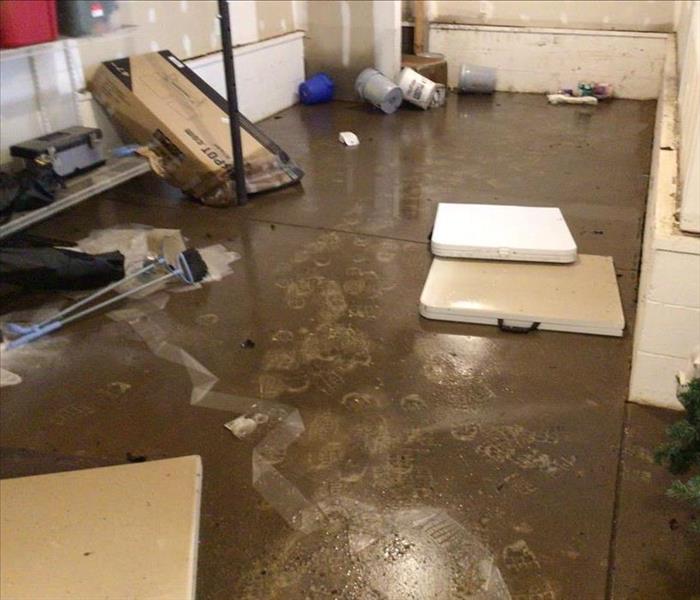Emergency Steps to Take After Burst Pipes
2/14/2024 (Permalink)
 With these emergency actions in your toolbag, you'll be better equipped to tackle burst pipes head-on and protect your home from extensive damage.
With these emergency actions in your toolbag, you'll be better equipped to tackle burst pipes head-on and protect your home from extensive damage.
Burst pipes are the unwelcome guests that can turn your home into a wet disaster. To be prepared for a pipe burst event, let's dive into the essential emergency steps you should take. Quick response is the name of the game, and here's your playbook.
1. Shut Off the Water Supply
When faced with burst pipes, your immediate action should be to locate and shut off the main water supply. This crucial step halts the flow of water and prevents further damage. The main shut-off valve is typically located near the water meter or where the main line enters your home. Familiarize yourself with its location beforehand to save precious time during an emergency.
2. Electricity Off, Safety On
Water and electricity don't mix well. To ensure your safety, turn off the electricity supply to the affected area or the entire house if necessary. This precautionary step helps prevent electrical shocks and minimizes the risk of electrical fires. Remember, safety first!
3. Open Faucets
Once you've shut off the main water supply, open all faucets in your home. This helps release any remaining water and reduces pressure in the pipes, mitigating the extent of the damage. Don't forget to flush toilets to drain water from the tank and bowl.
4. Identify the Source
Track down the source of the burst pipes. This might require a bit of detective work, but identifying the specific location of the damage is crucial for effective repairs. Look for visible leaks, water stains, or bulging areas on walls and ceilings.
5. Call in the Professional
While quick actions can minimize immediate damage, it's essential to call in professionals to assess and repair the burst pipes. Experienced plumbers have the expertise and tools to address the burst pipe issue. It is also important to call water mitigation professionals to clean up the mess and restore your property to its original state.
In conclusion, responding to burst pipes requires a quick and systematic approach. Shut off the water supply, secure your electrical system, open faucets to relieve pressure, identify the source of the problem, and don't hesitate to bring in professional help. With these emergency actions in your toolbag, you'll be better equipped to tackle burst pipes head-on and protect your home from extensive water damage.
Tips to Prevent Flooding in Your Basement
7/5/2023 (Permalink)
Your basement is an important space in your home, providing extra storage, a cozy hangout spot, or even a home gym. However, basement flooding can quickly turn it into a soggy mess, causing significant damage and inconvenience. To help you protect your basement from flooding, we've put together some friendly tips that can save you time, money, and stress.
Maintain Proper Grading: Ensure that the ground surrounding your home slopes away from the foundation. This helps direct rainwater away from your basement, reducing the risk of flooding. Regularly inspect and adjust the slope if necessary, paying attention to any signs of erosion.
Clear Gutters and Downspouts: Clean your gutters and downspouts regularly to prevent clogs and ensure proper water flow. When gutters are blocked, rainwater can overflow and seep into your basement. Extend downspouts away from the foundation, ideally by at least five feet, to redirect water safely.
Install a Sump Pump: Consider installing a sump pump in your basement. This device automatically detects water levels and pumps out excess water to prevent flooding. Regularly test your sump pump to ensure it is functioning properly, and keep a backup power source in case of electricity outages.
Seal Foundation Cracks: Inspect your basement walls and floors for any cracks or gaps. Seal these openings using appropriate waterproofing materials to prevent water from seeping through. Addressing foundation issues promptly can significantly reduce the risk of basement flooding.
Install Window Well Covers: If your basement has windows at or below ground level, install window well covers. These covers keep rainwater, leaves, and debris from accumulating in the window wells and potentially causing flooding.
Check Plumbing and Water Appliances: Inspect your basement's plumbing regularly for leaks, drips, or any signs of water damage. Additionally, ensure that water-related appliances, such as washing machines, water heaters, and sump pump discharge pipes, are properly maintained and functioning.
Consider Interior Drainage Systems: If your basement is prone to flooding, consider installing an interior drainage system. These systems collect and redirect water away from your basement, protecting it from potential water damage.
Remember, disaster can strike unexpectedly, even with the best preventive measures in place. In such unfortunate events, don't panic! SERVPRO of Harnett County East and Sampson County North is here to help. Our experienced professionals specialize in restoring and cleaning up after water damage incidents. With our prompt response and advanced techniques, we will assist you in getting your home back in order as soon as possible.
By implementing these preventive measures, you can significantly reduce the risk of basement flooding and protect your valuable space from water damage. However, if flooding does occur, trust SERVPRO of Harnett County East and Sampson County North to provide reliable and efficient restoration services. We are committed to restoring your home to its pre-flood condition and helping you regain peace of mind. Remember, when disaster strikes, SERVPRO is just a call away!
 With these emergency actions in your toolbag, you'll be better equipped to tackle burst pipes head-on and protect your home from extensive damage.
With these emergency actions in your toolbag, you'll be better equipped to tackle burst pipes head-on and protect your home from extensive damage.

 24/7 Emergency Service
24/7 Emergency Service